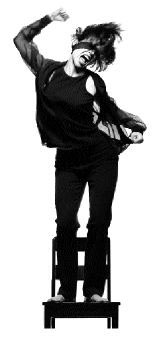PEGGY PIACENZA AND TONYA LOCKYER
On the Boards, 100 West Roy, 217-9888, $10-$15 8 p.m. Fri.-Sun., Feb. 22-24
CHAMBER DANCE COMPANY
Meany Theater, University of Washington, 543-4880, $12 8 p.m. Thur.-Sat. and 2 p.m. Sun., Feb. 21-24
PEGGY PIACENZA and Tonya Lockyer have been thinking about edges. But for these two artists, the lines have different meanings and purposes.
For Piacenza, an edge serves as a frame, a way of focusing attention. At the beginning of her new trio, For Whom Am I (which I recently saw in rehearsal), we see her laying tape on the floor, creating an edge for the dancing space. Over and over, this image of a frame comes into the piece, like an expanding rectangle in an animation sequence, like the little box directors make with thumbs and forefingers to isolate a particular shot. The frame directs our view—it creates the difference between what we look at and what we ignore. Piacenza’s movement style is not especially pedestrian (you wouldn’t mistake the fluttering hands and sweeping legs for everyday behavior), but as the performers look around through binoculars and take Polaroid snapshots of each other, their actions create a unified artwork from a Fellini-like collection of objects and events. It’s a dance because they make it so.
Tonya Lockyer is interested in the line between cultures. In previous works, she has collaborated with artists from Poland and Russia, as well as her native Canada. In this new dance, Borderland, her colleagues are from Iran and Turkey. Underneath the specifics of language and other cultural practices, movement offers a direct connection between people, the possibility of contact skin to skin. If the body is a territory, then the skin is a border, and our actions together are a journey we take trying to find some common ground, some mutual source. Borderland asks, “How do we meet each other? How do we
come to live and work together, despite our differences?”—questions that have a more powerful resonance today than ever. In this case, crossing the border, bridging the edge, has become an imperative.
MODERN dance was founded on a tradition of personal expression and has continued to insist that new artists make new dances. While this often gives performances the excitement of birth, it can also mean that we fail to conserve our past. So it is particularly satisfying to see the Chamber Dance Company and its special repertory of historical dance works.
Perhaps this ensemble of professional dancers in residence at the UW takes its tone from the scholarly nature of its home, but even if that’s just a coincidence, their concerts are a welcome view onto the development of the art form. In the past they’ve offered performances of works no longer in active repertories and even saved dances that were thought to be all but lost, giving us a look at the family album of modern dance.
This year’s program has a German theme running through it, contrasting the work of Dore Hoyer, one of the leading exponents of the expressionist dance style developed in 1930s Germany, with Hanya Holm, who was responsible for bringing that style to the United States and infusing it with other American elements. Hoyer’s Affectos Humanos, created the year before she committed suicide in 1967, is the culmination of the German side of that line, while Ratatat (1982) by Holm, also a late career work, is lighter and more abstract. Completing the program are Anna Sokolow’s tension-filled Rooms (1955) and the lively Canonic 3/4 Studies, (1982) by Mark Morris.








